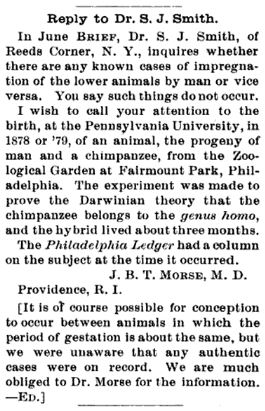An interesting claim, made by a physician, about a humanzee produced at the University of Pennsylvania, is shown in the screenshot above. However, extensive efforts to corroborate the good doctor's claim have yielded nothing. Anyone with additional information about this case is invited to contact the website.
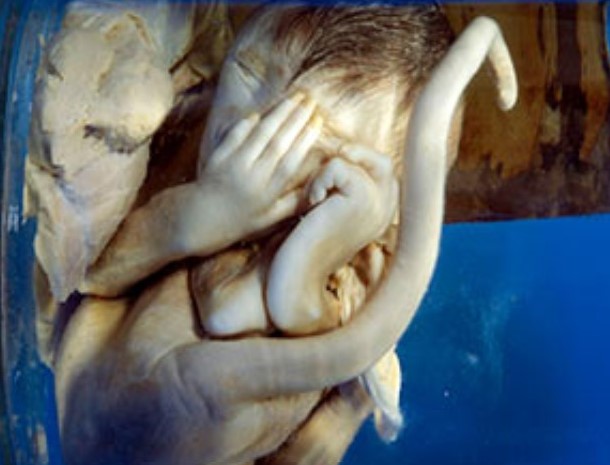 Given the long tail and handlike hindfoot, this specimen in the Museum Vrolik is a likely monkey-human hybrid (apes, sensu stricto, do not have tails).
Given the long tail and handlike hindfoot, this specimen in the Museum Vrolik is a likely monkey-human hybrid (apes, sensu stricto, do not have tails).Ape-human Hybrids
Mammalian Hybrids
This article quotes reports about either chimpanzee-human hybrids (what have been called humanzees) or monkey-human hybrids. Reports about orangutan-human hybrids are covered in a separate article. The reader should perhaps be told, too, that while monkeys are, informally, often called apes, true apes do not have tails.
Ape-human hybrids have been a viral topic on the internet. And many people think a cross between a human and a great ape might be feasible. Moreover, there have been many informal reports about such hybrids. However, biologists rarely investigate these controversial claims and, even when they do, they never seem to publish the results.
 Abductee Faye Ray in King Kong
Abductee Faye Ray in King Kong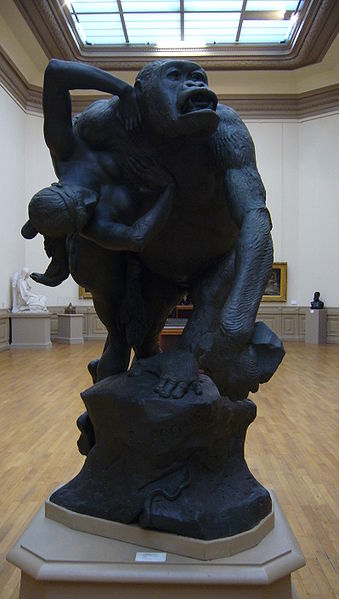 Gorille enlevant une Femme (Artist: Emmanuel Frémiet, Musée des Beaux Arts de Nantes).
Gorille enlevant une Femme (Artist: Emmanuel Frémiet, Musée des Beaux Arts de Nantes).
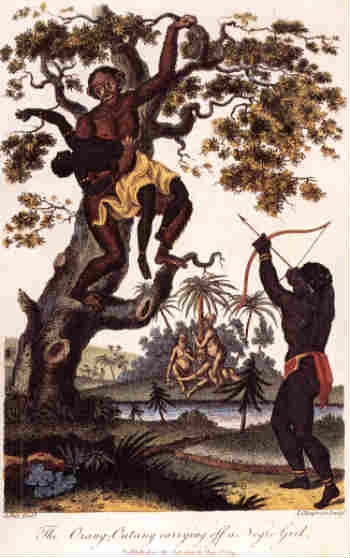 An eighteenth-century depiction of an ape abducting a woman. The caption reads “The Orang-outang carrying off a Negro Girl.”
An eighteenth-century depiction of an ape abducting a woman. The caption reads “The Orang-outang carrying off a Negro Girl.”
There are many stories about women being abducted and raped by apes. Some of these are presented as fiction, as in King Kong, others, as nonfiction. Thus, in an example of the latter, Maxse (1906) claims that the pygmies
Similarly, in writing about chimpanzees, Proctor (1877), claims that
As Proctor seems to imply, the victims in such claims of abduction were not limited to women. In fiction, Edgar Rice Burroughs has Kala, the she-ape, carry off the infant Tarzan. And there are many nonfictional reports about chimpanzees carrying infants off as prey and eating them. Not all such incidents end in tragedy, however. The English cleric Samuel Purchas (c. 1577 – 1626), published a collection of reports by travellers to foreign countries entitled Purchas His Pilgrimage. In one of them, Andrew Batell (c. 1565 – 1614) gives an account of his experiences in Angola. In a chapter on chimpanzees, which Batell called pongos, Purchas added a note which read,
Whether or not this story of abduction is true, it is a fact that staring at apes can provoke them to violence.
Dodds (2006) compiled various early accounts, dating back as far as the sixteenth century, about marooned European women being impregnated by apes. Typically in such stories, the woman has committed some transgression that results in her being left on an ape-infested desert island. There, she is whisked away to the cave of the Monkey King, where she is ravished and eventually gives birth to an ape-human hybrid. In the end, she is always rescued by a passing ship and her harrowing experience becomes known the world.
In his Description historique du royaume de Macaçar, Nicolas Gervaise (1700, p. 31) gives the following over-the-top description of macaques raping women.
Indeed, many of the indigenes of the regions where the African great apes reside seem to have perceived chimpanzees and gorillas as being within the range of human variation. Such views would, of course, contribute to any propensity for interbreeding. Duncan (1891, p. 9) specifically states that
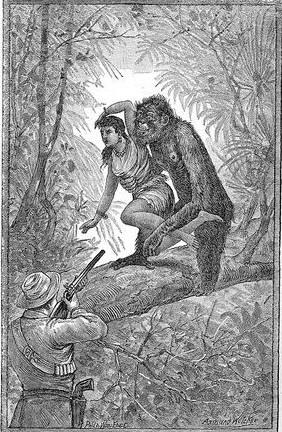
One might easily suppose that these notions of apes raping women were entirely fanciful. However, it seems that such things do occasionally occur. Thus, according to a recent news story, a wild chimpanzee was interrupted during an attempt to rape a female health worker in Ekiti State in southwestern Nigeria. Four previous rapes of local women by chimps were also blamed on the same individual, who was hunted down and killed. Orangutans have also been known to rape women (more info >>). Bears, too, have a bad rep for rape (more info >>), though the evidence is not so convincing as in the case of apes.
But now let's look at some of the many reports about ape-human hybrids.
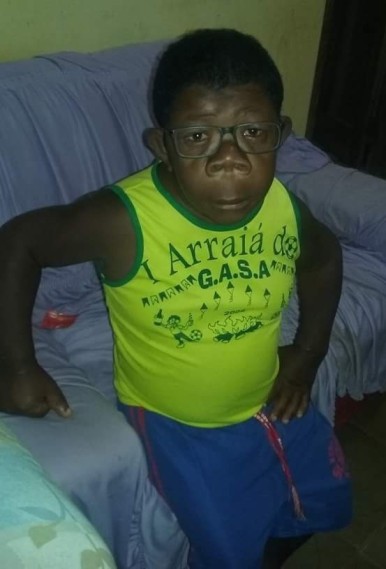 Augusto Dembo
Augusto DemboOliver. Years ago, I was contacted, as an expert on hybrids, by the owners of Oliver, the supposed chimpanzee-human hybrid ("humanzee"). I told them that Oliver had no obvious physical traits linking him to humans that are not present in normal chimpanzees. True, he spent more time walking upright than chimpanzees normally do. But chimpanzees can be trained to do many things that humans do. My own opinion is that the owners wanted to play up the idea that he was a human hybrid so that they could cash in on the controversy. I do think they succeeded in doing that. Other cases, however, provide better evidence for the existence of ape-human hybrids.
Azzo. Another case that received a good bit of media attention back in the 1930s was that of "Azzo the Ape-man." This was an individual, living in Morrocco's Atlas Mountains, who supposedly was intermediate between an ape and a human being. But judging from photos, it appears that the only trait connecting him with apes was a small cranium. It was so small that it would seem to classify him as a microcephalic. A small brain is, of course, a trait of apes as well. But it is also a trait of many human beings. No other features seem to connect him with apes. Indeed, the only other simian trait commonly mentioned in connection with Azzo was his supposedly long arms, which allegedly hung below his knees. One of the few photos showing his arms hanging at his sides, shown above, demonstrates that this claim about his arms simply wasn’t true. In short, it seems clear that he was simply a skinny microcephalic and not an ape-human hybrid at all.
Orange Park. In a 2018 interview, Gordon Gallup, a psychologist at the University at Albany in New York, claims that an ape-human hybrid was produced in a Florida laboratory in the 1920s. The Sun’s article states that
Gallup, who developed the famous mirror “self-recognition” test which proved primates could acknowledge their own reflection, claims his former university professor told him that a humanzee baby was born at a research facility where he used to work.
Speaking to The Sun Online, he said: “One of the most interesting cases involved an attempt which was made back in the 1920s in what was the first primate research centre established in the US in Orange Park, Florida.
“They inseminated a female chimpanzee with human semen from an undisclosed donor and claimed not only that pregnancy occurred but the pregnancy went full term and resulted in a live birth.
“But in a matter of days, or a few weeks, they began to consider the moral and ethical considerations and the infant was euthanised.”
Gallup said the professor worked at Yerkes before the research centre moved to Emory University in Atlanta, Georgia in 1930.
He added: “He told me the rumour was true. And he was a credible scientist in his own right.”

Ivanov
Ivanov. During the 1920s Russian biologist Il'ya Ivanov attempted to produce ape-human hybrids by impregnating chimpanzees with human semen (Rossianov 2002). However, he managed to carry out only three such inseminations, so his failure to produce any actual hybrids is not surprising. Hybrid crosses typically require more, in some cases many more, inseminations to produce a pregnancy than do ordinary matings between two animals of the same kind.
Wethersfield, New York. The Star-Gazette (Elmira, N.Y., May 26. 1894, p. 6, col. 4; ||yaxl4oh8) ran a notice about a nondescript born at Wethersfield. The relevant part of the report said that
Parkersburg, West Virginia. A woman supposedly gave birth to an ape-human hybrid in Parkersburg in 1888. From the St. Louis Post-Dispatch, (Oct. 7, 1888, p. 6, col. 2):
Henderson County, Kentucky. The following appeared in the Indianapolis, Indiana, State Sentinel (Oct. 31, 1883, p. 5, col. 1):
Contrary to popular belief, many hybrids do have a composite appearance in which the front part of the body is closely similar to one parent and the hind portion, similar to that of the other. So it's possible, at least in terms of the general rules of hybridization, that the creature described in this Kentucky report actually did have an upper half like an ape, but a lower one like a human being. Indeed, it's interesting that most, though not all, of the descriptions given in reports say that the putative hybrid resembled an ape in its upper parts and a human in its lower.
Article continues below
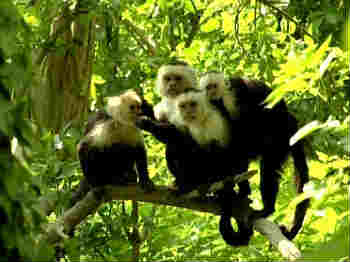 Capuchin monkeys (Cebus capucinus)
Capuchin monkeys (Cebus capucinus)
Wilmington, North Carolina. Another such birth reportedly took place in the Brooklyn neighborhood of Wilmington in 1874. The report is from the Wilmington Star. (quoted in the Patriot, Greensboro, N.C., Apr. 1, 1874, p. 2, col. 6), was copied from The primate sire implied seems to be a capuchin, which was the kind of monkey normally kept by organ grinders.
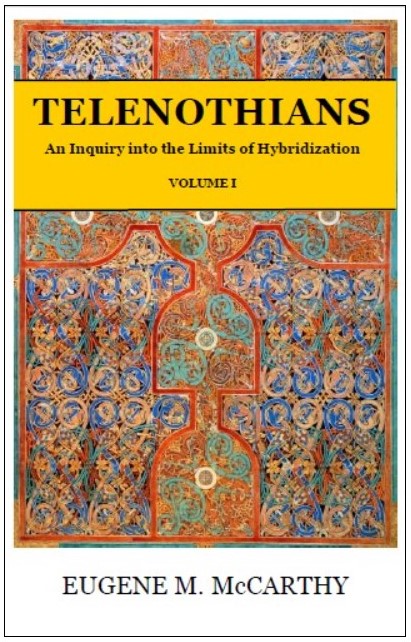
Richmond, Mississippi. In the Medical and Surgical Reporter (1861, vol. 6, p. 318; ||yxfjyspp), Dr. M. M. Davis,† who at the time was residing at Richmond, Mississippi, gives the following account of the expelled uterine contents of a woman "who had taken a great fancy to a monkey, and miscarried."
New Orleans, Louisiana. The report below, alleging that a woman gave birth to a baboon-like offspring, is from the New Orleans Crescent (quoted in the Washington, N.C., North State Whig Oct. 6, 1841).
Article continues below
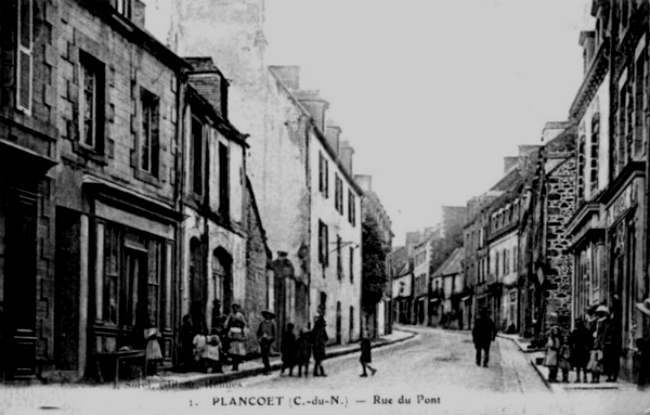 A nineteenth-century view of Plancoët.
A nineteenth-century view of Plancoët.
Plancoët, Brittany. In a report (“Sur une fille qui ressembloit d’une guenon”) that appeared in the journal Recueil Périodique d’Observations de Médecine, Maréchal (1757, pp. 231-232) describes a “girl” in his hometown of Plancoët: “Some years ago there died here in Plancoët a five-year-old girl who looked
Note that in this last cited case (Plancoët), nothing is mentioned about the individual in question having any human traits. The only human connection, at least by the description, was that she was the offspring of a human mother. So there is nothing to indicate a composite (hybrid) character. However, it seems highly unlikely that any woman would choose to adopt an ordinary ape and pass it off as her child. So perhaps this was simply a case of a hybrid closely resembling only one of its parents, which here would be the ape sire. Such hybrids, with a biased resemblance toward one parent, are known to occur in a wide variety of mammalian crosses.
Wittenberg. The German periodical Wittenbergsches Wochenblatt (March 8, 1776, p. 76) states that on January 21, 1771, the wife of a manual laborer gave birth to a stillborn fetus with the head and face of a monkey (the term used in the German original was Meerkatze, which generally refers to any primate belonging to the family Cercopithecidae, i.e., Old World monkeys).
Article continues below
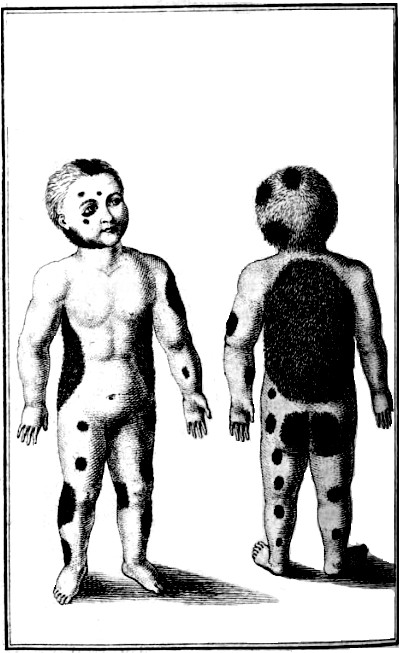 The Soldin Nondescript. A supposedly true-to-life copperplate etching of a female offspring birthed by a woman at Schönberg in 1768 (Schönwald 1774).
The Soldin Nondescript. A supposedly true-to-life copperplate etching of a female offspring birthed by a woman at Schönberg in 1768 (Schönwald 1774).
Schönberg. In the beginning of a long report describing what may have been an ape-human hybrid, Dr. C. G. Schönwald (1774, pp. 565-566) wrote "In January 1768, in the village of Schönberg near Soldin in East Brandenburg [since 1945, Myślibórz in Poland], the wife of a farmer named Friedrich Neumann gave birth to a daughter whose entire back from the neck down to the small was like an ape, and covered with the same kind of hair, which reached on both sides to the sides of the stomach. In addition, there were various larger and smaller patches of the same kind, both on the child's body and on her face" (translated by E. M. McCarthy). The mother was 34 years old and already given birth to 11 children without mishap. Schönwald says the figure above is accurate and that the brown hair was like that of an ape or monkey (German Affe could mean either) and so thick that the skin could not be seen through it. He accounted for this case in terms of the now discredited theory of maternal impressions in which a mother's offspring is shaped by things that a mother sees during pregnancy. In this case, she had seen an ape in the street.
Article continues below
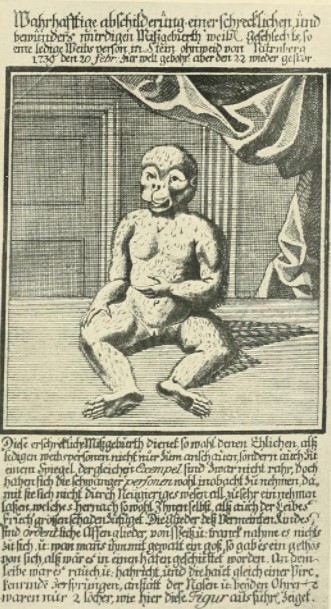 According to an eighteenth-century pamphlet, a woman in the town of Stein, in Germany, a few miles southwest of Nuremberg, gave birth to an ape-human on Feb. 20, 1739. Supposedly, this nondescript, a female, died two days after birth. The report was accompanied by the picture above. (Source)
According to an eighteenth-century pamphlet, a woman in the town of Stein, in Germany, a few miles southwest of Nuremberg, gave birth to an ape-human on Feb. 20, 1739. Supposedly, this nondescript, a female, died two days after birth. The report was accompanied by the picture above. (Source)
Guinea. As used here, the name Guinea refers, not to the modern country, but to the region of Africa historically designated by that name, which includes all of the countries on the Gulf of Guinea (today, those between, and including, Ghana and Angola). Bognan (1990, p. 25) states that in 1738 a colonial American newspaper carried an advertisement about an ape-human hybrid. The creature, it claimed, “was taken in a wood at Guinea; ’tis a female about four feet high in every part like a woman excepting her head which nearly resembles the ape.” This is apparently the same creature subsequently described in the London Magazine (Sep. 1738, pp. 464-465):
From the report, then, it's unclear whether this creature from Carolina was simply a chimpanzee or a nondescript intermediate between humans and chimpanzees.
There are, however, early reports from the Guinea region specifically referring to hybridization between humans and apes. Antonio Zucchelli (1663-1716), the Italian Franciscan capuchin friar, was a missionary in Africa from 1698 to 1702. In his account of his travels in Brazil and Africa, he tells of women being impregnated by monkeys or, possibly, apes (the term used in the Italian original was "Macachi grandi," which cannot here refer to a macaque, as macaques do not occur in sub-Saharan Africa). So the term is here translated vaguely as "big monkeys," where monkeys is meant in its broad sense as including apes. The only primates that in this broad sense would qualify as big monkeys, and that are native to northern Angola (the location of Luanda), would be yellow baboons (Papio cynocephalus), chimpanzees (Pan troglodytes) and gorillas (Gorilla gorilla). The passage in question is here translated from a German edition of his book Zucchelli 1715, pp. 147-148. It reads,
Rochester, England. In the Philosophical Transactions of the Royal Society (1741, no. 461, pp. 764-767), William Gregory, a physician practicing in Rochester, gives an account of a woman giving birth to a fetus "resembling a monkey," but give no particulars as to the appearance of this tertium quid, nor does he provide a picture. According to his statements, the birth occurred in September 1731.
Trévoux, France. Another case is that of a nondescript born at Trévoux, a suburb of Lyon, on October 18, 1713 (Le Brun 1714). It lived three days. Briefly, the child or hybrid, as may be, had a flat nose, large canines, a severely cleft palate, long arms, legs and digits and a hairy body. These features, together with the fact that the mother was in charge of the daily care of an ape (“singe”) belonging to a local resident, led to the conclusion that her offspring was in fact a hybrid. However, the French word singe, as in the case of its English counterpart ape, is used loosely to refer to monkeys as well as apes proper (i.e., gibbons, chimpanzees, bonobos, gorillas and orangutans). So even if it were known that this creature was in fact an ape-human hybrid, there would remain a question as to the exact type of primate involved.
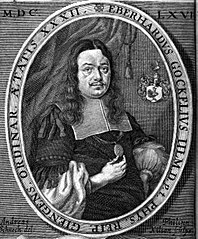
1636-1703

1652-1722
Ulm, Germany. Ulm physician Eberhard Gockel (1700, p. 151) states that "A year or two ago, I attended the wife of a military constable ("Steckenknechts") who gave birth to an infant whose upper body was like that of an ape" (translated by E. M. McCarthy).
Paris. Nicolas de Blégny (1652-1722), personal physician to King Louis XIV, said a discussion was held in the Academy of Sciences in Paris about a woman who had birthed a child that was hairless, but which "was like an ape with respect to its face, arms, legs and trunk, with the exception of its hair" (Blégny, 1686, pp. 96-97). He also said he had seen it himself. (Many reports about human-animal hybrids mention the absence of a hair coat.) It was invested in a fleshy layer, he said, like a toga, which led some to say the mother's imagination had been affected by the sight of an ape in a toga she had seen on stage while pregnant, and that this was the reason her child had been born having the appearance it did. This case is clearly the same as that described in the second volume of Philosophical Transactions of the Royal Society (1667, pp. 479-480).
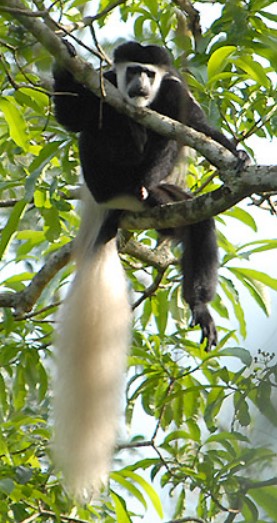
Blégny mentions that it also lacked thumbs. All primates have five digits on their thumbs, except for the spider monkeys of South America and the colobus monkeys of Africa, in both of which the thumb is small or absent. Wooly spider monkeys (genus Brachyteles), which are structurally intermediate (and thus likely derived from hybridization) between spider monkeys and wooly monkeys, also either have small thumbs or entirely lack them. A black-and-white colobus (Colobus guereza) is shown at left.
Saxony-Anhalt, Germany. In a book describing cases he had encountered during the course of his work, Philipp Salmuth (1648, p. 66, obs. 15 ), a physician practicing in Saxony-Anhalt (in both Dessau and Zerbst), writes,

1627-1682
Blasius. The Dutch physician and anatomist Gerhard Blasius (1627-1682) gives the following account. "Aberrations worthy of consideration were present in a twelve-year-old boy, who was exhibited for profit by his parents. Scarcely two feet tall, with the face of an ape, he produced no articulate voice, only a harsh hissing and laughter. He was extremely hairy all the way down to his thighs…The pregnant mother had been frightened by a baboon" (Blasius 1674, pp. 123-124; translated by E. M. McCarthy).
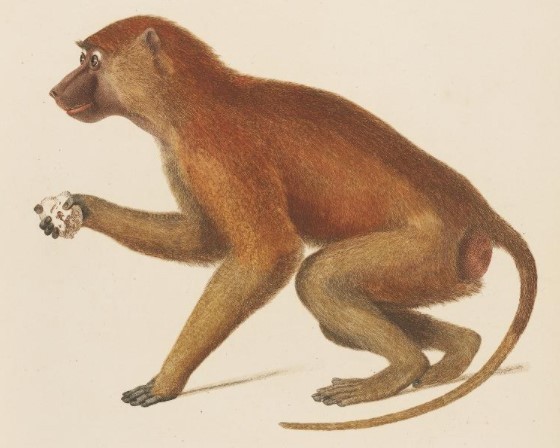
A baboon, as depicted by Jean-Baptiste Audebert (1799; ||yzclffy2). Note the similarity of the hind feet and tail to the Museum Vrolik specimen pictured at the top of this page.
Baboons. By this time, the reader may have noticed that a good many of the reports about ape-human hybrids refer to baboons. These animals have, for a long time, had a reputation for taking a violent sexual interest in women. Thus, the French artist and naturalist Jean-Baptiste Audebert (1799) commented that
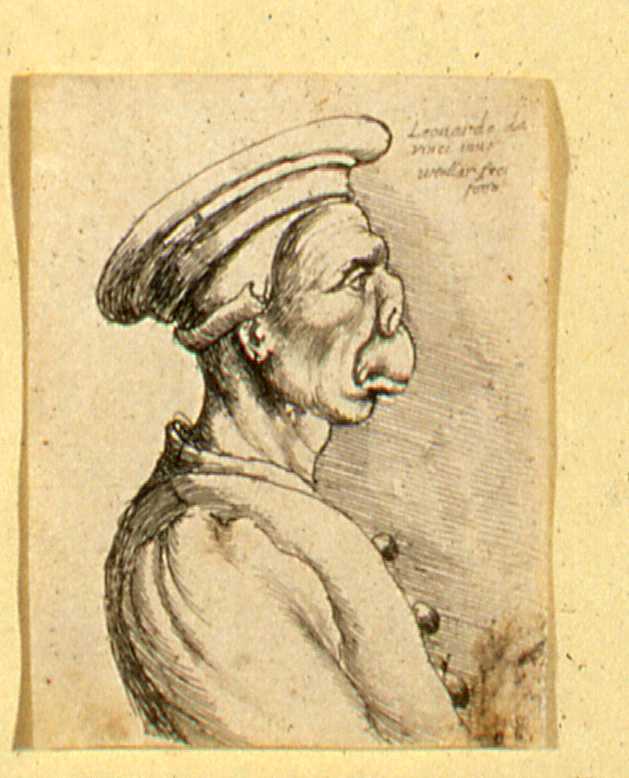
Man with an ape-like nose and mouth (1660)
Wenceslaus Hollar, after Leonardo da Vinci
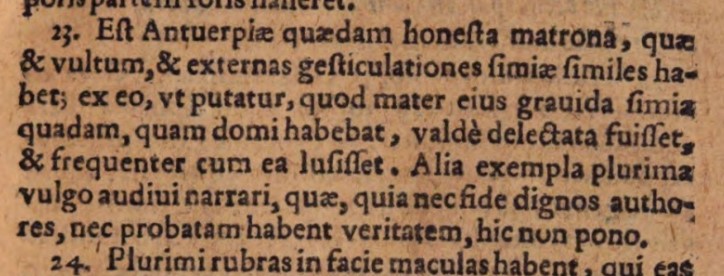
Passage in which a professor of medicine at the University of Leuven, Thomas Fienus, claims that a woman was then living in Antwerp, who had a face like an ape and who made gestures like an ape (Fienus 1608, p. 11p).
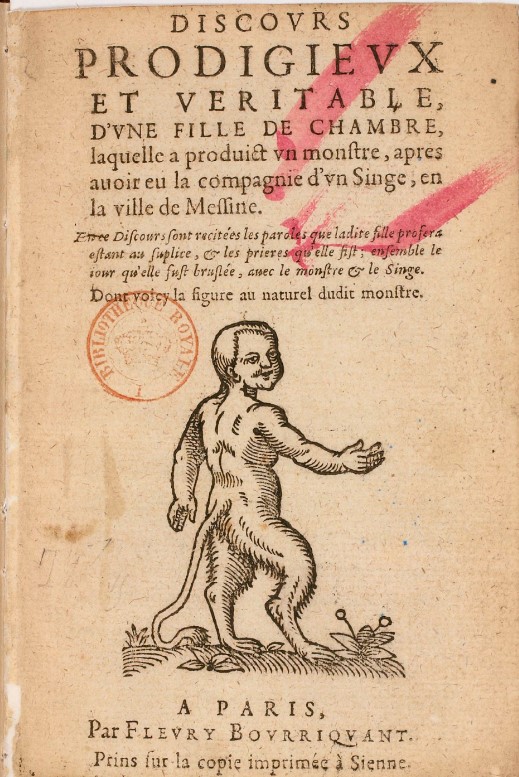
Title page of a pamphlet published in Paris in 1598 by Fleury Bourriquant.
Messina. The picture shows the title page of a pamphlet telling the tale of a supposed ape-human hybrid being birthed at Messina by a 19-year-old girl by the name of Hippolyta Biscontina. The author, Fleury Bourriquant, says that under torture Biscontina eventually admitted to having repeated engaged in coition with a pet ape. He goes on to say that she was then publically tormented with pincers in all the crossroads of the town before being burnt at the stake, along with the supposed ape sire and her hybrid offspring (which according to the report had lived only three days). In the illustration, note the tail, which would seem to preclude the idea of a chimpanzee-human hybrid. Indeed, Bourriquant's description ("a large ape with a tail") suggests a baboon. Hamadryas baboons (Papio hamadryas), in particular, have a long history of domestication, dating back to early Egyptian times. Bourriquant based his information on a Siennese original, now apparently lost.
Hamadryas baboons. In Yemen, Hamadryas baboons, also known as dog-faced baboons, have been popular as sex partners for both men and women, and in Sudan and Ethiopia women are reported to smuggle them into harems to have sexual relations with them (Edwardes 1959; Masters 1962; Bagley 1968). Hamadryas baboons were sacred in ancient Egypt (hence, their alternative name, Sacred Baboon), where both men and women reportedly engaged in sex with them (Masters 1962; Bagley 1968; Ramsis 1969). They are known to have been present in Egypt at a very early date (Predynastic Period). They were popular there as pets, and tomb paintings show them on leashes or playing with the children of the household. When temple baboons died, priests performed the Opening of the Mouth ceremony upon them, something usually reserved for humans. They were mummified and adorned with jewelry and buried in wooden or limestone coffins. In many cases they were worshiped after death as incarnations of the god Osiris. The mummified remains of Tuthmosis II’s pet baboon were found sharing his tomb. The Egyptians considered sacred baboons as among the most lustful of animals, which was perhaps their reason for adding their feces to aphrodisiac salves.
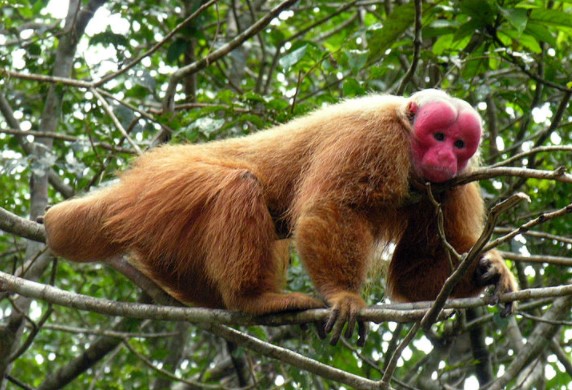
Bald uakaris (Cacajao calvus), which reside mainly in the Amazonian drainage of Peru, seem to fit the imagination's notion of a human-monkey hybrid.
Pedro Cieza de León In his book Crónicas del Perú (1554, part 1, pp. 170-171) the Spanish conquistador Pedro Cieza de León says that when he questioned the indigenies of Peru about the peoples inhabiting the interior, he was told, among other things, that they hybridized with some kind of large ape residing there. Cieza de León's tale is more dubious than most accounts mentioning ape-human hybrids, first because he says himself that he is relying on hearsay and, second, because there are no large apes in South America. The largest would probably be one of the howler monkeys, which weigh only about 15 pounds at maturity. At any rate, the following is an English translation of the relevant passage.

A passage in Sir Edward Coke’s Institutes of the Lawes of England, stating that the English statute against buggery, passed in the 25th year of the reign of Henry VIII (1533), was extended to encompass women because “somewhat before the making of this Act, a great Lady had committed Buggery with a Baboon, and conceived by it, etc.” The etcetera may have been included to imply that the pregnancy came to term. The Institutes are a series of legal treatises widely recognized as a foundational document of the common law. They have been cited in over 70 cases decided by the Supreme Court of the United States (source: 1648, part 3, p. 59; ||32muzuzr).

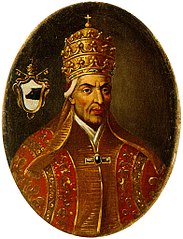 Alexander II (reigned 1061-1073), the only 11th century pope of that name.
Alexander II (reigned 1061-1073), the only 11th century pope of that name.
Damian. In his De bono religiosi status et variarum animantium tropologia, the 11th-century cardinal Saint Peter Damian has a chapter on apes [Ch. XXIX]. In it, he tells of a certain Count William of Liguria, in northern Italy, whose pet monkey became his wife’s lover. The animal in question is referred to as a "maimo," which may refer to a macaque, since the eighteenth-century naturalist Buffon refers to the Pig-tailed Macaque (Macaca nemestrina) as the "Maimon" (and since the French-language version of Wikipedia redirects the query maimon to the page for M. nemestrina). Given that most macaques are native to southeast Asia, the only macaque that would have been easily accessible to an eleventh-century Ligurian count would have been the Barbary Macaque, also known as the Barbary Ape (Macaca sylvanus), which is native to northwestern Africa. The relevant passage in translation reads,
Now what follows is something I heard from the lord Pope Alexander less than a month ago. He told me that recently Count William, who lives in the district of Liguria, had a male monkey, called a maimo in the vernacular. He and his wife, a completely lewd and wanton woman, used to play in shameless fashion with him. I myself have met his two sons, whom this vile woman, who deserves a beating, had borne of a certain bishop whose name I will omit, because I do not enjoy defaming anyone. She often used to play with the lecherous animal, taking it in her arms and fondling it, and the monkey in the meantime gave signs of being aroused and tried with obvious effort to come close to her nude body. Her chambermaid said to her, “Why don’t you let him have his way so we can see what he is after?” What more should I say? She submitted to the animal, and, what a shameful thing to report, it mated with the woman. This thing became habitual, and she frequently repeated the unheard of crime.
One day when the count was in bed with his wife, the maimo, aroused by jealousy, suddenly jumped on both of them, tore at the man with his arms and sharp claws as if he were his rival, got him by the teeth and wounded him beyond all recovery. And so the count died. Because the innocent man had been faithful to his wife and had fed this animal at his own expense, he had expected no evil from either. He had shown them only kindness. But what a heinous crime! The wife shamefully ignored his marriage rights, and the beast sank his teeth in his master’s throat.
It was reported to the same pope while I was with him that a certain boy, who seemed big for his age, even though, as it was said, he was already twenty years old, was still completely unable to speak. Besides, he had the appearance of a maimo, and that was also what they called him. And so the unfortunate suspicion arose that something like a monster, I will not say a wild animal, was being brought up in its father’s house. [Translated in: Peter Damian. Letters 61-90, O. J. Blum translator, Letter 86, pp. 296-297.]
Many people doubt the existence of ape-human hybrids. But such a notion is far less controversial than the idea of humans successfully creating offspring with animals considered more distantly related. And yet, many such hybrids have been reported and some of these more distant crosses are far better documented than those between humans and the various apes. If you want to learn more about some of these more distant human-animal crosses, follow the links in the list below.
An old news notice about “Heine and Fritz” >>
An old news notice about an ape-human hybrid >>
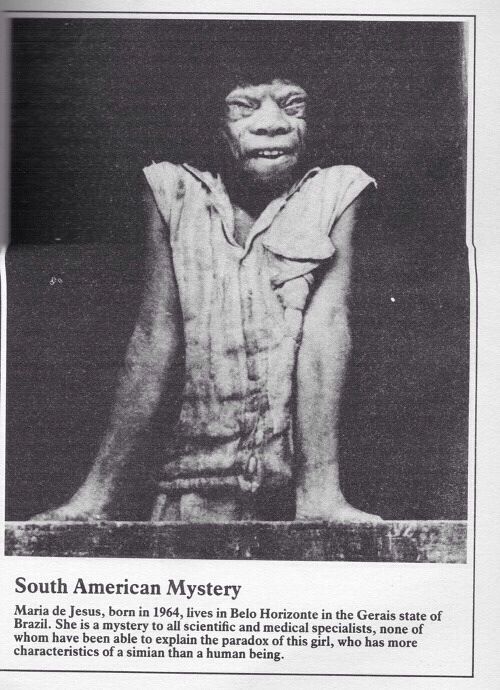
Incertae Sedis
A woman, Maria de Jesus, born in Brazil in 1964 has been alleged to have had many simian characters. However, although her appearance in the photo above is abnormal, she seems to have no traits that are specifically apelike. Possibly she does represent a hybrid of some kind, but what kind, if any, is unclear, thus the classification here of incertae sedis.
By the same author: Handbook of Avian Hybrids of the World, Oxford University Press (2006).
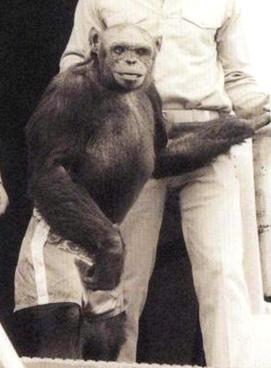
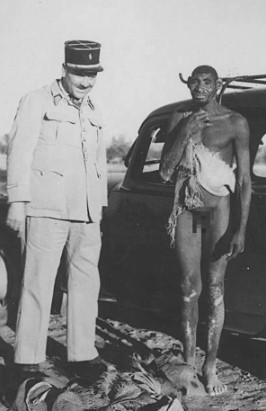
 Gordon Gallup
Gordon Gallup